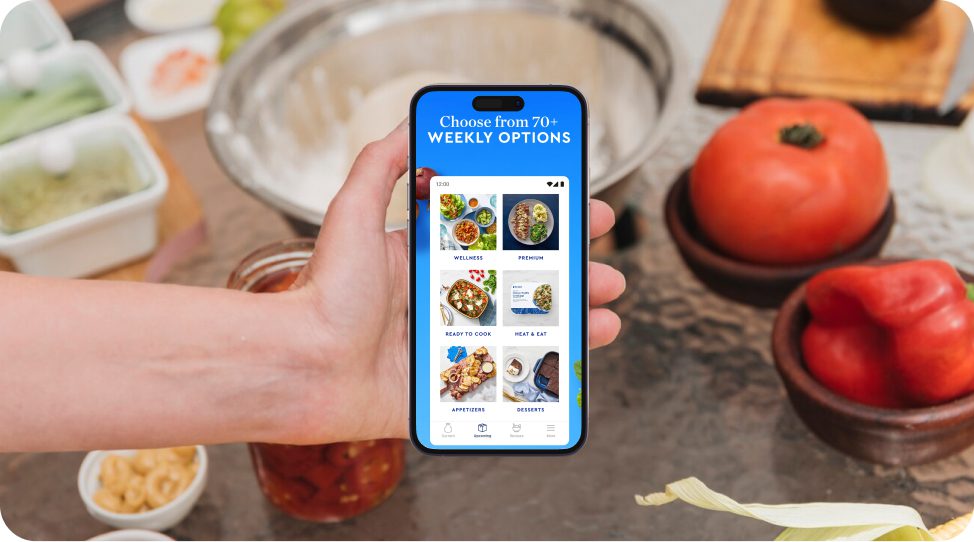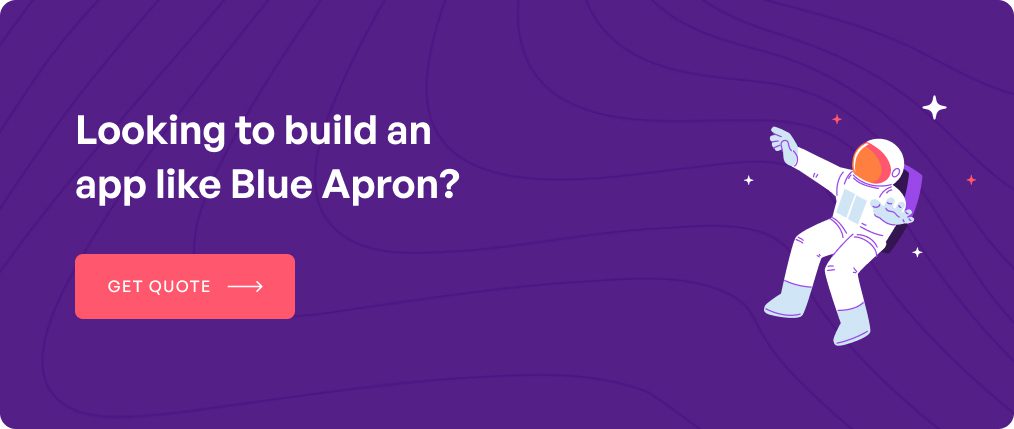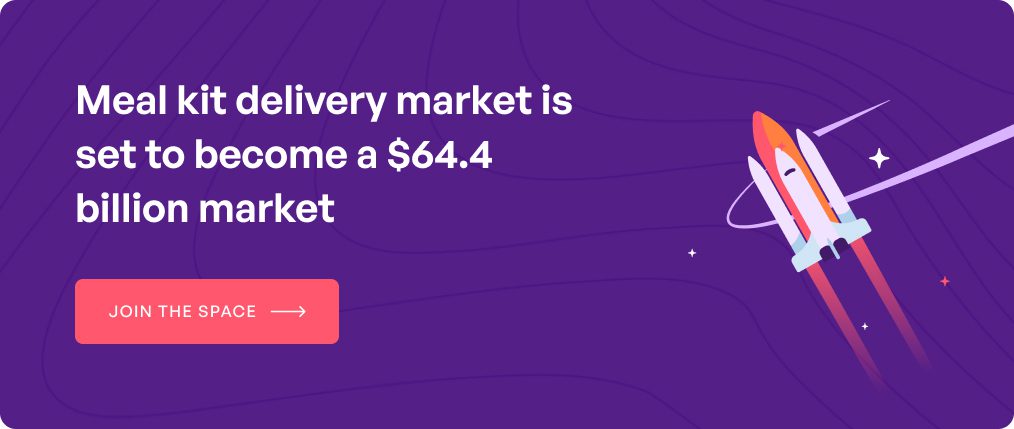Just when we thought that the food delivery app sector had hit a stage of no growth, a new innovation was born.
After being a sector with limited growth in terms of new players and unique features since the past some years, the food delivery market is witnessing a new entrant – meal kit delivery apps.
The idea behind this domain is to make it easy for users to order pre-made meal kits and prepare recipes at home, which otherwise would take up a lot of effort.
Presently dominated by a few names like Hello Fresh, EveryPlate, Home Chef, and Blue Apron, the meal kit delivery industry is expected to reach $64.3 billion by 2030.
Noting the growth trajectory that the industry is operating on, several entrepreneurs are showing interest in entering the space.
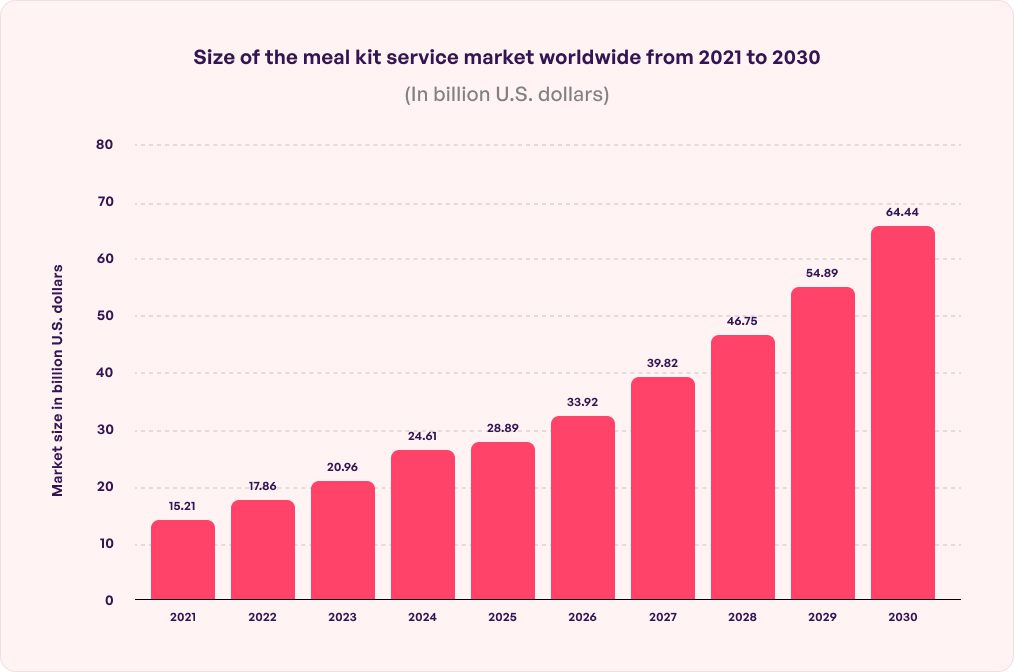
Now the first question that they have when looking to enter the industry is the meal kit delivery app development cost.
Let us get you the answer to it before we move to the cost-impacting elements like features, design system, etc. of a meal prep delivery app.
Table of contents
How much does it cost to develop meal kit delivery app?
The cost of meal kit delivery app development is dependent on a number of factors – features of the meal kit delivery application, number of platforms it is going to be active on, complexity of the design system, and the team structure, location working on it.
Here’s a quick look into the stages wise meal kit delivery application cost –
| Stage | Hours Range | Cost Range |
| Market Research and Planning | 100-200 hours | Varies on research |
| Design and Prototyping | 200-400 hours | $10,000 – $30,000 |
| Development | 800-1500+ hours | $50,000 – $150,000+ |
| Testing and Quality Assurance | 200-400 hours | $10,000 – $30,000 |
| Deployment and Launch | 100-200 hours | Varies on server/hosting costs |
| Post-Launch Support | Ongoing | 20-25% of the development cost per year |
As you can see, the cost of meal kit delivery services is dependent heavily on the complexity of the application which in turn is based on the feature sets, technology integration, and design systems.
Let us look into these individual components to truly gather the understanding of meal prep delivery solutions development.
Must-have features of meal kit delivery app
When you build a meal delivery service like hello fresh or Blue Apron, you invest in two applications (on an MVP level) – Grocery outlets and Customers’. If your budget is high, you can consider adding another solution in the mix that will be used primarily by your admin. In the MVP stage, you can merge the grocery and MVP version in one application with the stores not having a view of the admin section.
Here are the customers-facing features of a meal kit delivery app.
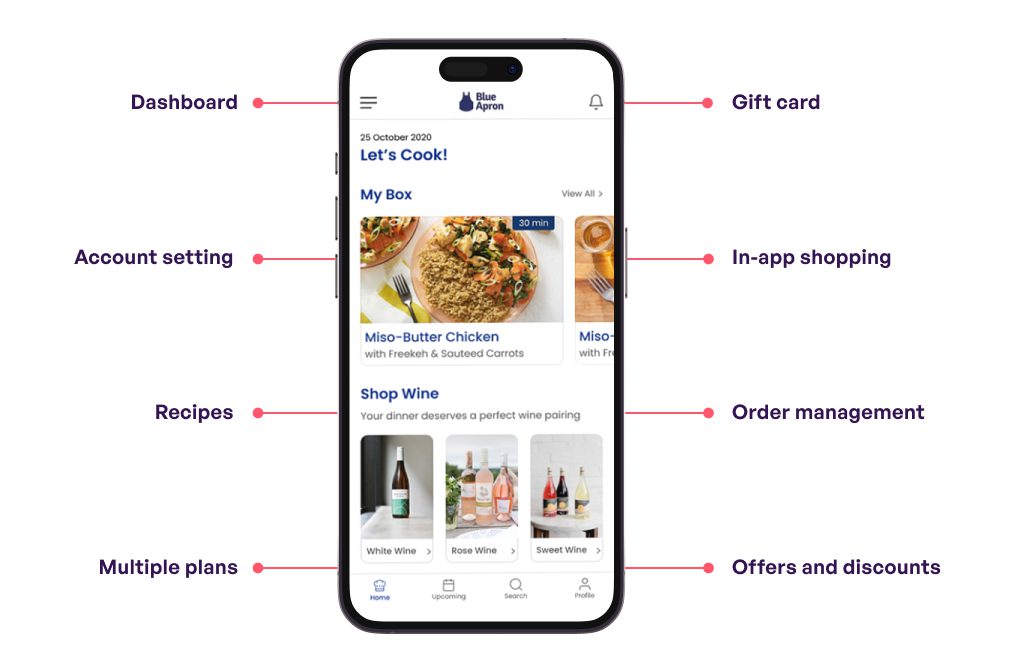
Dashboard
Usually on the first screen post app launch, the dashboard should have a mix of multiple elements: recipes – both new and time-tested, order status, eCommerce items, etc.
Since there would be multiple elements on this screen, we recommend following a minimalist approach that would make it easy for users to move in-app.
Recipes
Recipes are the core feature of a meal kit delivery app. The idea here is to give a list of recipes for people to choose from along with the meal kits that would go into making them. These recipe pages should be made to be as detailed as possible with information around their contents, meal prep time and complexity, delivery time,sorting feature to refine the recipe according to the number of people etc.
Multiple plans
With new dietary trends such as veganism, Keto, and Paleo diet etc. emerging on an everyday basis, it will help to offer diet specific meal kits to the customers. This would increase the chance of you becoming the go-to meal prep ordering app of health conscious users.
In-app shopping
Blue Apron has an in-app wine store from where the users can buy wine alongwith their meal kits. You can also think something around this line by having an in-built eCommerce section of seasonings, beverages, cooking utensils, and other accompaniments.
Gift cards
The functionality specific to Blue Apron application deals with offering gift cards to the customers as a way to share the application’s experience with their acquaintances. This helps with organic, low effort app promotion greatly.
Account setting
The account section of online meal kit delivery services app usually have information around the user’s data surrounding address, age and contact number, billing details, order summary and history, complaints, reviews, etc.
Order management
The order management part of the meal prep delivery app makes it possible for the customers to perform multiple order related tasks – track order, modify and cancel them before they get shipped, get order invoice, view (and repeat) past orders.
Offers and discounts
One of the sureshot ways for businesses to ensure continuity in this soon to be competitive space is to offer discounts to their new users and customers. To manage this, there should be a discount mechanism incorporated at the checkout phase.
Now that we have looked at the features of meal kit delivery app, the next stage to consider when planning out the meal prep ordering app specifications is the design system.
When you look at Blue Apron, you will find their application, right from user flow to elements and interfaces to be extremely intuitive and organic. The design system that they are following can be taken up as the inspiration of the base of your MVP-level application – one which will expand based on new features additions.
With the design part addressed, there’s another element that would help shape the advantages of the meal kit delivery service – technology combinations.
While Blue Apron has kept their technology stack closed, here’s what we believe their tech combinations would be.
Probable tech stack of meal prep ordering app
Blue Apron’s meal kit delivery app likely used a technology stack that includes various components for both its mobile app and backend systems. While we don’t have an access to their specific technology choices, we can provide you with a general idea of the technologies commonly used in similar on demand delivery app development apps:
Mobile App (iOS and Android):
1. Programming Languages: Swift for iOS and Kotlin for Android are common choices.
2. Development Frameworks:
- For iOS, they might have used Apple’s native development framework.
- For Android, Google’s Android SDK and Android Studio.
3. Front-end Development:
- Native UI components and libraries for each platform.
- Possibly React Native or Flutter for cross-platform development.
Backend:
1. Server-side Languages:
- Ruby, Python, Java, or Node.js are common choices for developing the backend.
2. Web Frameworks:
- Ruby on Rails, Django, Spring Boot, Express.js, or similar frameworks.
3. Database Management:
- Relational databases like PostgreSQL or MySQL for data storage.
- NoSQL databases like MongoDB for flexible data storage.
4. APIs:
- RESTful APIs for communication between the mobile app and the backend.
- Payment gateway APIs for processing transactions.
- Geolocation APIs for tracking and delivery.
- Messaging services for notifications (e.g., Twilio or Firebase Cloud Messaging).
5. Cloud Services:
- Amazon Web Services (AWS), Google Cloud Platform (GCP), or Microsoft Azure for hosting and cloud services.
6. Security:
- HTTPS for secure data transfer.
- Authentication and authorization systems (e.g., OAuth2, JWT).
- Encryption and hashing for data security.
Infrastructure and DevOps:
1. Containerization and Orchestration:
- Docker for containerization and Kubernetes for orchestration.
2. Continuous Integration/Continuous Deployment (CI/CD):
- Tools like Jenkins, Travis CI, or GitLab CI for automating the development pipeline.
3. Monitoring and Logging:
- Tools like Prometheus, Grafana, ELK Stack, or commercial solutions for monitoring and logging.
Payment Processing:
1. Payment Gateway Integration:
- Stripe, PayPal, or other payment gateways for processing customer payments.
These are the common technologies that many meal kit delivery apps tend to use. Blue Apron may have chosen specific technologies and frameworks based on their unique requirements and preferences. It’s important to note that technology stacks can evolve over time as new tools and frameworks become available and as the business needs change.
Here were the different technical end specifications of meal prep delivery app development. The last and final item that would contribute to the cost is the team structure and location and this is where the hours details come in handy.
The average development hour: cost range for an on demand app development services company in USA falls between $120-$140, while the same for a location like India is in the range of $50-$80 per hour. Thus, the company you partner with will carry a huge impact on the investment you will need to make.
With this, we have looked at all the different facets of meal prep ordering app development and now what is important to know is how to get a competitive advantage. Let us look at some points that we would share with our clients looking to build an app similar to Blue Apron.
- Show video recipes of every menu item for an easy follow through
- Show the source of raw materials’ origin for better transparency
- For select menu, have a prime-delivery functionality for real-time meal kit delivery.
Looking for more ideas? Get in touch with our on-demand delivery experts who understand the domain perfectly in terms of what the users expect and the direction in which the market is heading.


